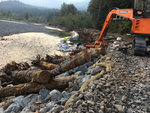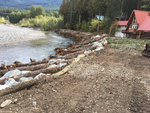

Residents of the Timberline community in East Lewis County are throwing a party Saturday to celebrate the completion of a project to save part of their neighborhood from Cowlitz River erosion.
“It’s very, very satisfying,” said county commissioner Gary Stamper, whose East County district includes the neighborhood. “It’s probably, with all the projects I’ve been involved with for the last four years, it went as smoothly as one could ever ask as far as government projects.”
The community will be holding a dedication ceremony at 11 a.m. Saturday at the end of the cul-de-sac on Coal Creek Drive, thanking the local, state and federal officials who helped rush the project to completion. Members of the Timberline Community Association have lost three homes to erosion since 1978, and further washouts had at least two more poised to be claimed by the river.
“We are in a state of emergency,” Association president Steve Albert told Stamper in November. “These two houses are in immediate danger of floating down the Cowlitz River.”
Normally, the county can’t conduct projects on behalf of private homeowners, but the erosion was also threatening a county road, and officials quickly determined the project would be mutually beneficial. Still, environmental permitting requirements meant it was unlikely to get underway before 2019, at which time the houses might already be lost.
That’s when Lewis County environmental planner Ann Weckback got “creative,” according to county manager Erik Martin. She determined that an existing revetment — or retaining wall — had already been placed in that portion of the river, meaning the county could attach its work to that and classify much of it as maintenance, rather than go through the permitting for a brand-new project.
Under pressure from Rep. Jaime Herrera Beutler, R-Battle Ground, the Federal Emergency Management Agency agreed to cover 75 percent of the project, and state Rep. Ed Orcutt, R-Kalama, secured another $125,000 in the capital budget. The $1 million-plus project ended up costing the county less than $100,000, and workers recently finished the project.
The project involved anchoring logs along about 600 feet of the riverbank. Over time, they will collect sediment and build up a more stable, long-term bank.
“When that water slows down, sediment falls between logs,” Martin said in August. “Over time you get this bank-building effect.”
Albert said he was impressed by the coalition of elected leaders and behind-the-scenes government workers who realized the urgency of the project.
“Getting to that point of getting to approval, it’s insane,” he said in August, as work was underway. “It’s completely a miracle. … People in the neighborhood are extremely thankful.”
Martin said the county was pleased to be able to get to work on a faster-than-expected timeline.
“It was really kind of the perfect storm of things, as well as some really good digging by Ann and some good outside-the-box thinking that allowed us to go forward and go ahead and construct that project this summer,” he said. “We now have a project that not only protects a county road, but the ancillary benefit is it also protects several properties and homes up there. … It was pretty amazing. It’s not normally you see a project like that get done in that short amount of time.”